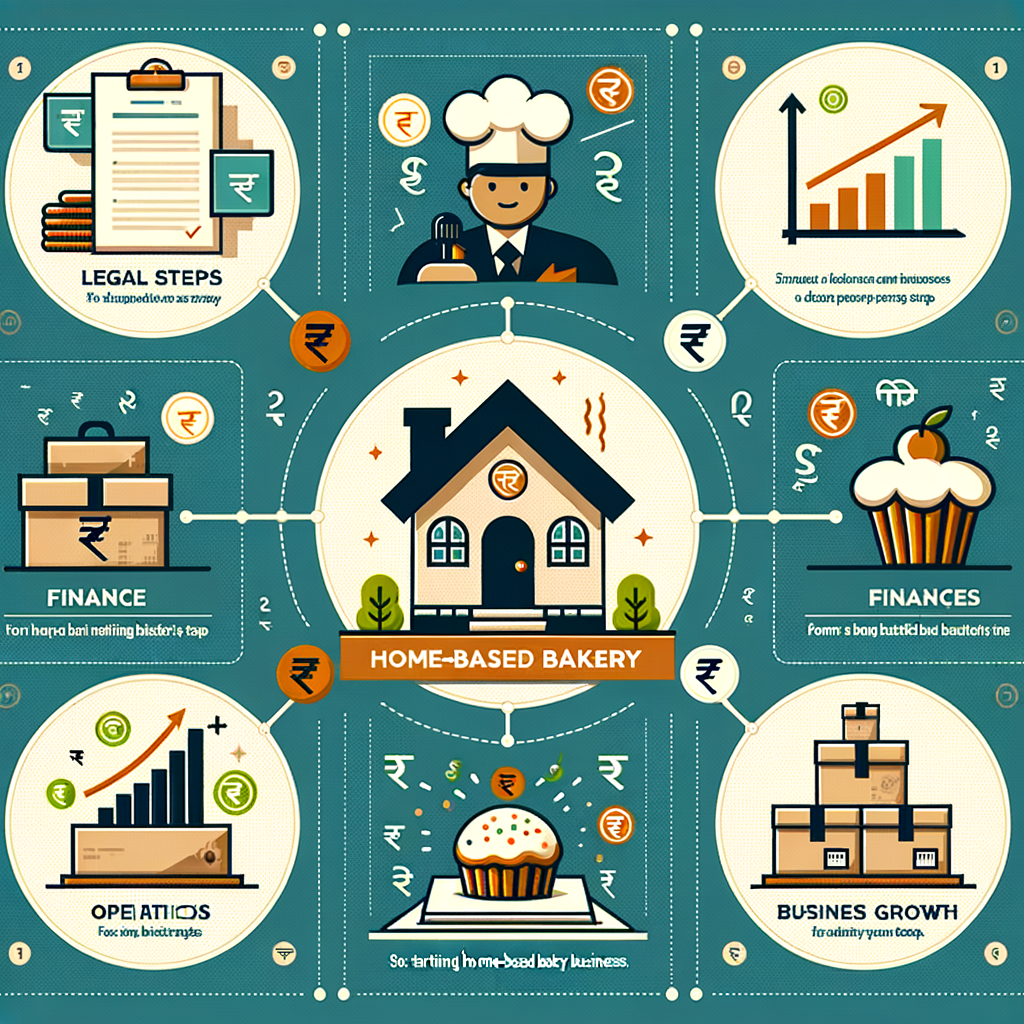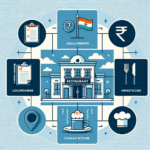How to Start a Home-Based Bakery Business in India: A Step-by-Step Guide
The sweet aroma of freshly baked goods is no longer just a comforting scent from your kitchen; it’s a booming business opportunity. In recent years, a growing wave of passionate home bakers has successfully turned their hobby into a thriving venture, enjoying the freedom of being their own boss while creating delicious products. This comprehensive guide will walk you through all the essential steps you need to start a home-based bakery business in India, covering everything from initial planning and legal compliance to marketing and managing your finances. Whether you’re a salaried individual seeking a rewarding side hustle or an aspiring entrepreneur looking for a low-investment business model, this is your chance to turn your passion into profit.
Is a Home-Based Bakery Business in India a Profitable Idea?
Absolutely. The demand for unique, high-quality baked goods has never been higher, and operating from home gives you a significant competitive edge. A profitable home-based bakery in India is not just a dream; it’s a very achievable reality thanks to several key advantages. First and foremost are the low overhead costs. You eliminate the single biggest expense for most businesses—rent. Your utility bills may see a slight increase, but it’s marginal compared to renting a commercial space. Furthermore, the modern consumer is actively seeking out artisanal, customized, and healthy baking options that aren’t available in mass-market stores. This allows you to build direct, personal relationships with your customers, receive immediate feedback, and build a loyal community around your brand. As your business grows, you have the flexibility to scale your operations at your own pace without the pressure of heavy initial investments.
Step 1: Create a Solid Business Plan and Find Your Niche
Every successful business starts with a well-thought-out plan. It acts as your roadmap, guiding your decisions and helping you stay focused on your goals. Your plan doesn’t need to be a hundred-page document; a simple, clear strategy is far more effective. It forces you to think critically about who you are as a brand, what you will sell, and who your ideal customer is. This foundational step is crucial before you invest a single rupee, as it helps identify potential challenges and opportunities early on, setting the stage for a successful launch and sustained growth for your venture.
Finding Your Niche: Unique Home Bakery Business Ideas India
The Indian market is filled with bakers, so standing out is key to attracting customers. Instead of trying to be everything to everyone, specializing in a particular niche will make your brand more memorable and appealing to a specific target audience. By focusing on one area, you can perfect your craft, streamline your operations, and become the go-to expert. This specialization is a powerful marketing tool in itself.
Here are some unique home bakery business ideas India to consider:
- Celebration Cakes: Focus on creating stunning, customized cakes for birthdays, weddings, and anniversaries.
- Gourmet Cookies & Brownies: Offer a curated menu of classic and exotic flavoured cookies, brownies, and blondies.
- Healthy & Diet-Specific Bakes: Cater to the growing health-conscious market with keto-friendly, vegan, gluten-free, or sugar-free options.
- Artisanal Breads: Specialize in handcrafted breads like sourdough, focaccia, baguettes, and multigrain loaves.
- Fusion Indian Desserts: Create innovative sweets that combine traditional Indian flavours with classic baking techniques (e.g., Gulab Jamun Cheesecake, Rasmalai Cupcakes).
- Pet-Friendly Treats: Tap into the pet parent market by offering safe, healthy, and delicious baked treats for dogs and cats.
Drafting Your Simple Business Plan
Once you have your niche, draft a simple one-page business plan. This document will be your north star as you start your journey.
Here are the key components to include:
- Business Name: Choose a name that is catchy, memorable, and reflects your brand’s personality. Check for its availability on social media and as a domain name.
- Menu & Speciality: Clearly list the 5-10 core products you will offer initially. Start small and expand as you grow.
- Pricing Strategy: Develop a preliminary idea of your pricing. Research competitors, but don’t just copy them. Factor in your unique quality and costs.
- Target Audience: Define your ideal customer. Are they families in your neighbourhood? Corporate clients looking for gift boxes? Health-conscious millennials?
- Initial Budget: Create a rough estimate of your startup costs, including equipment, initial batch of ingredients, packaging, and any registration fees.
Step 2: Legal & Tax Registrations for Your Home-Based Bakery Business
This is arguably the most critical step in transitioning from a hobbyist to a professional business owner. Completing the necessary legal and tax registrations is not just about compliance; it’s about building a trustworthy and legitimate brand that customers can rely on. Proper registration protects you from legal penalties and opens doors to future opportunities like partnerships, loans, and selling on larger platforms. Tackling this step correctly from the beginning is fundamental to learning how to start bakery in India the right way.
FSSAI Registration: The Mandatory Food License
The FSSAI (Food Safety and Standards Authority of India) license is non-negotiable. Anyone selling food products in India, whether from a large factory or a home kitchen, must be registered with the FSSAI. This assures your customers that your products are prepared in a hygienic environment and are safe for consumption.
There are two main types of licenses relevant to home bakers:
- Basic FSSAI Registration: This is the starting point for most home bakers. It is mandatory for businesses with an annual turnover of up to ₹12 lakh.
- State FSSAI License: As your business grows, you will need to upgrade to a State License once your annual turnover is between ₹12 lakh and ₹20 crore.
The application process is entirely online and can be completed through the official FSSAI FoSCoS portal. You can apply for your registration here: FSSAI FoSCoS Portal.
GST Registration: When and Why?
GST (Goods and Services Tax) registration can seem confusing, but the rules are quite clear for a home-based bakery business. GST is an indirect tax levied on the supply of goods and services.
Here’s when you need to register:
- Turnover Threshold: GST registration is mandatory if your annual turnover from selling goods (like cakes and cookies) exceeds ₹40 lakh. For some special category states (e.g., North-Eastern states), this threshold is lower at ₹20 lakh.
- E-commerce Clause (Very Important): This is a crucial point many new entrepreneurs miss. If you plan to sell your products through an e-commerce platform like Zomato, Swiggy, Amazon, or even your own website with a payment gateway, you are required to have a GST registration from day one, regardless of your turnover. Understanding the nuances of GST for E-commerce Businesses: Key Considerations is vital.
Once registered, you will collect GST from your customers and remit it to the government. Sales within your state will involve CGST (Central GST) and SGST (State GST), while sales to other states will involve IGST (Integrated GST). You can manage your GST compliance through the Official GST Portal.
Udyam Registration (MSME)
Registering your business under the Udyam portal as a Micro, Small, and Medium Enterprise (MSME) is highly recommended. It is a completely free, paperless registration that provides a host of benefits. These include access to government schemes, eligibility for priority sector lending from banks (which means easier access to business loans at lower interest rates), and various tax rebates. This registration gives your small business a recognized status and can be a significant advantage as you grow. You can learn more about the entire process with our guide on MSME UDYAM REGISTRATION. You can register for free on the Udyam Registration Portal.
Other Potential Registrations
Depending on your state and the scale of your operations, you might also need a Shop and Establishment Act license. This license is governed by state laws and regulates conditions of work, working hours, and other employee-related matters. While many small-scale home bakeries might not require it initially, it’s wise to check the specific regulations of your local municipal authority to ensure full compliance, especially if you plan to hire help.
Step 3: Setting Up Your Kitchen, Sourcing, and Packaging
With the legal paperwork in motion, it’s time to focus on the heart of your business: your kitchen and your products. This is where you bring your delicious ideas to life. The key is to start smart, focusing on quality and efficiency without overspending. Your setup, ingredients, and packaging are direct reflections of your brand’s quality and professionalism, so giving them careful thought is essential for making a great first impression on your customers.
Essential Equipment & Sourcing
You don’t need a professional commercial kitchen to start. Your home kitchen is your biggest asset. To begin, you can use much of the equipment you already own.
The absolute essentials include:
- A reliable Oven (OTG or convection microwave)
- A good quality Stand Mixer or Hand Mixer
- A Digital Weighing Scale for precision
- Measuring Cups and Spoons
- Basic Baking Pans, Tins, and Trays
- Spatulas, Whisks, and Mixing Bowls
For ingredients, quality is paramount. It’s what will set your products apart. While it might be tempting to buy from the nearest supermarket, sourcing from local wholesalers or specialized online baking supply stores can significantly reduce your costs without compromising quality. Buy in bulk for non-perishable items like flour, sugar, and chocolate to get better prices.
Smart Packaging and Branding
Your packaging is the first physical interaction a customer has with your brand. It should be sturdy enough to protect your delicate creations and beautiful enough to enhance the customer experience. You don’t need to spend a fortune on custom-printed boxes initially.
Here are some cost-effective yet professional ideas:
- Use standard, sturdy cardboard boxes for cakes and cookies.
- Design a simple, elegant logo and get it printed on branded stickers. You can place these on the boxes, butter paper, or ribbons.
- Include a small, handwritten “thank you” note in each order. This personal touch goes a long way in building customer loyalty.
- Ensure your FSSAI license number and contact information (like your WhatsApp number or social media handle) are clearly visible on the packaging.
Step 4: Pricing, Marketing, and Taking Orders
Creating amazing products is only half the battle; selling them is the other half. This phase is all about the commercial side of your business: setting the right price, reaching your target audience, and creating a smooth process for taking and fulfilling orders. A smart strategy in these areas will ensure your business is not just a creative outlet but also a financially successful one.
How to Price Your Products Correctly
One of the biggest mistakes new home bakers make is underpricing their products. You are not just selling ingredients; you are selling your skill, time, and creativity. A simple and effective way to price your products is to use a cost-plus formula.
Here’s a breakdown:
- Total Cost = Ingredient Cost + Overhead Cost (electricity, gas, water) + Packaging Cost + Your Time (Labour Cost)
- Selling Price = Total Cost + Profit Margin
Don’t forget to assign a monetary value to your time! For the profit margin, a range of 30% to 50% is a good starting point, but this can go higher for highly customized or complex orders. Research what other bakers in your niche are charging, but price based on your value, not just theirs.
Actionable Home Baking Business Tips India
Marketing your home bakery doesn’t require a big budget. With a bit of creativity and consistency, you can build a strong customer base.
Here are some effective home baking business tips India:
- Master Social Media: Instagram and Facebook are your best friends. Invest time in taking high-quality, mouth-watering photos and videos of your products. Use relevant hashtags like `#homebaker[yourcity]`, `#cakedecorating`, `#customcakes`, and engage with your followers by running polls and Q&A sessions.
- Leverage WhatsApp Business: Set up a WhatsApp Business account. Use its catalog feature to create a beautiful, easy-to-browse menu. It’s an excellent tool for taking orders directly, communicating with customers, and sending out updates on new products or offers.
- Encourage Word-of-Mouth: Your happiest customers are your best marketers. Gently encourage them to share photos of their orders and leave reviews on your social media pages. Offer a small discount on their next order for every successful referral.
- Network Locally: Don’t underestimate the power of your immediate community. Market your business in your apartment complex’s WhatsApp group, local community forums, and collaborate with local event planners, small cafes, or gift shops.
Step 5: Managing Finances and Filing Taxes
Once the orders start rolling in, it’s crucial to have a system for managing your finances. This is a non-negotiable aspect of running a professional business. Proper financial management not only helps you understand the health of your business and track profitability but also makes tax filing significantly easier and stress-free. As experts in finance and taxation, we at TaxRobo cannot stress this enough: get your financial habits right from day one.
Basic Accounting for Your Business
You don’t need to be an accountant, but you do need to be diligent. The first and most important step is to open a separate bank account for your business. A current account is ideal. This keeps your personal and business finances from getting mixed up, providing a clear picture of your income and expenses. Use a simple spreadsheet or a user-friendly accounting app to meticulously track every single sale and every single purchase, no matter how small. This record-keeping is vital for calculating your profits and filing accurate tax returns.
Understanding Your Income Tax Obligations
The income you earn from your bakery is classified as “Profits and Gains from Business or Profession” under the Income Tax Act. You are legally required to declare this income and pay tax on it.
For a small home-based bakery business, the government has provided a wonderfully simple method called the Presumptive Taxation Scheme under Section 44AD.
- What it is: This scheme simplifies tax compliance immensely. Instead of maintaining detailed books of accounts and calculating profit by subtracting every expense from revenue, you can simply declare your profit as a fixed percentage of your total annual turnover. Dive deeper into the benefits of Section 44AD: Presumptive Taxation Scheme for Small Businesses.
- How it works: You can declare your net profit to be 8% of your total turnover. If you receive payments through digital modes (like UPI, bank transfer, debit/credit card), you can declare an even lower profit of 6% on those receipts.
- Eligibility: This scheme is available to businesses with an annual turnover of up to ₹2 crore. This makes it a perfect fit for most home bakers in their initial years.
This simplifies your year-end tax filing process significantly. You can find more details on the official Income Tax Department website.
Conclusion
Launching a home-based bakery business is an incredibly rewarding journey that blends passion with entrepreneurship. By following these structured steps—creating a solid plan, completing all necessary legal registrations like FSSAI and GST, setting up your kitchen smartly, marketing effectively, and managing your finances diligently—you can build a successful and sustainable business from the comfort of your home. The path from a passionate baker to a professional business owner is clear and achievable.
Starting a business involves critical legal and financial steps that can feel overwhelming. If navigating FSSAI registration, GST compliance, or income tax filings seems daunting, let the experts at TaxRobo help. Our team can ensure your profitable home-based bakery in India is fully compliant from day one, letting you focus on what you do best: baking! Contact us for a consultation today!
Frequently Asked Questions (FAQs)
1. Do I need a GST number to start a home bakery in India?
You need a GST number only if your annual turnover exceeds ₹40 lakh (or ₹20 lakh in some states). However, if you sell your products through e-commerce platforms like Swiggy, Zomato, or your own website that accepts online payments, GST registration is mandatory from the very beginning, regardless of your turnover.
2. What is the most important license for a home-based bakery business in India?
The FSSAI Basic Registration is the most critical and absolutely mandatory license required to legally operate and sell food products in India, ensuring your business complies with food safety standards.
3. Can I run my home bakery from a rented house?
Generally, yes. However, it is essential to review your rental agreement for any clauses that may prohibit commercial activities. It’s also a good practice to be mindful of your housing society’s rules and ensure your business operations do not cause any disturbance to your neighbours.
4. How much capital is needed to start a home baking business?
The startup cost can be very low. You can start with an initial investment of as little as ₹20,000 – ₹50,000 if you plan to use your existing home kitchen equipment. This cost would primarily cover initial ingredients, packaging, and registration fees. The investment will be higher if you need to purchase a new oven or other specialized machinery.
5. How do I decide the selling price for my cakes and cookies?
A reliable method is to calculate your total cost per item, which includes the cost of ingredients, packaging, a portion of your utility bills (electricity/gas), and a fair value for your time and skill (labour cost). To this total cost, you then add a profit margin, which is typically between 30% and 60%, to determine your final selling price.



